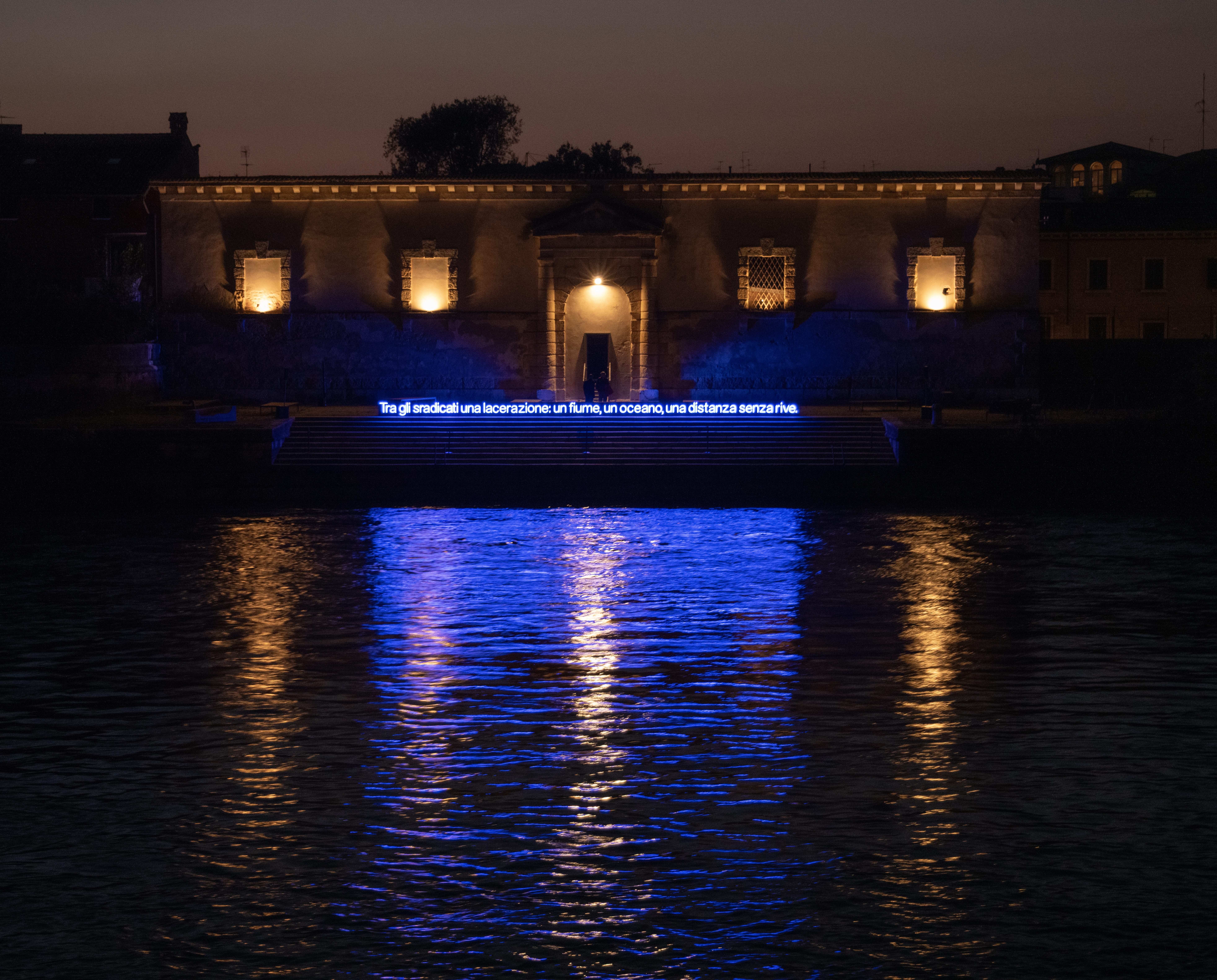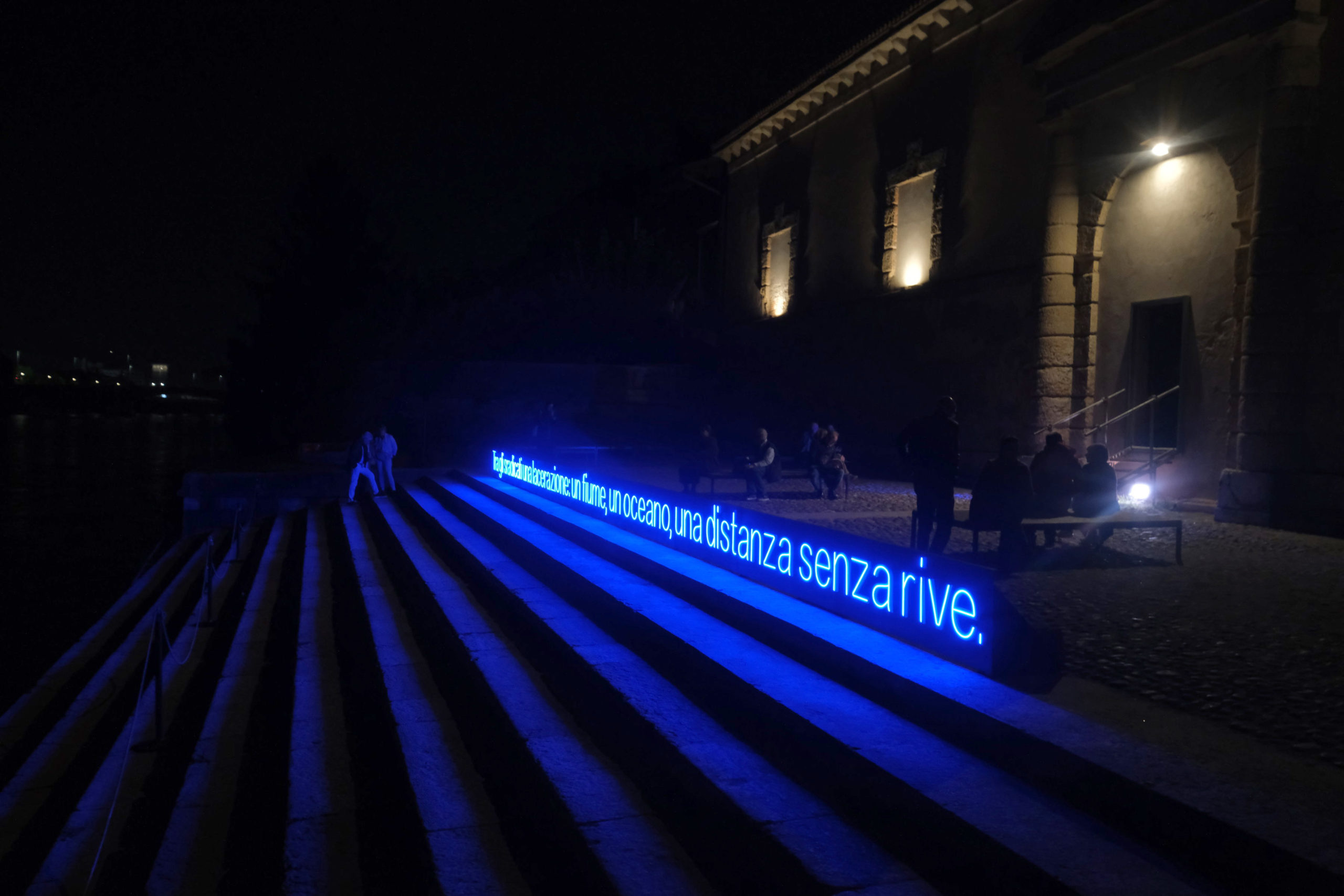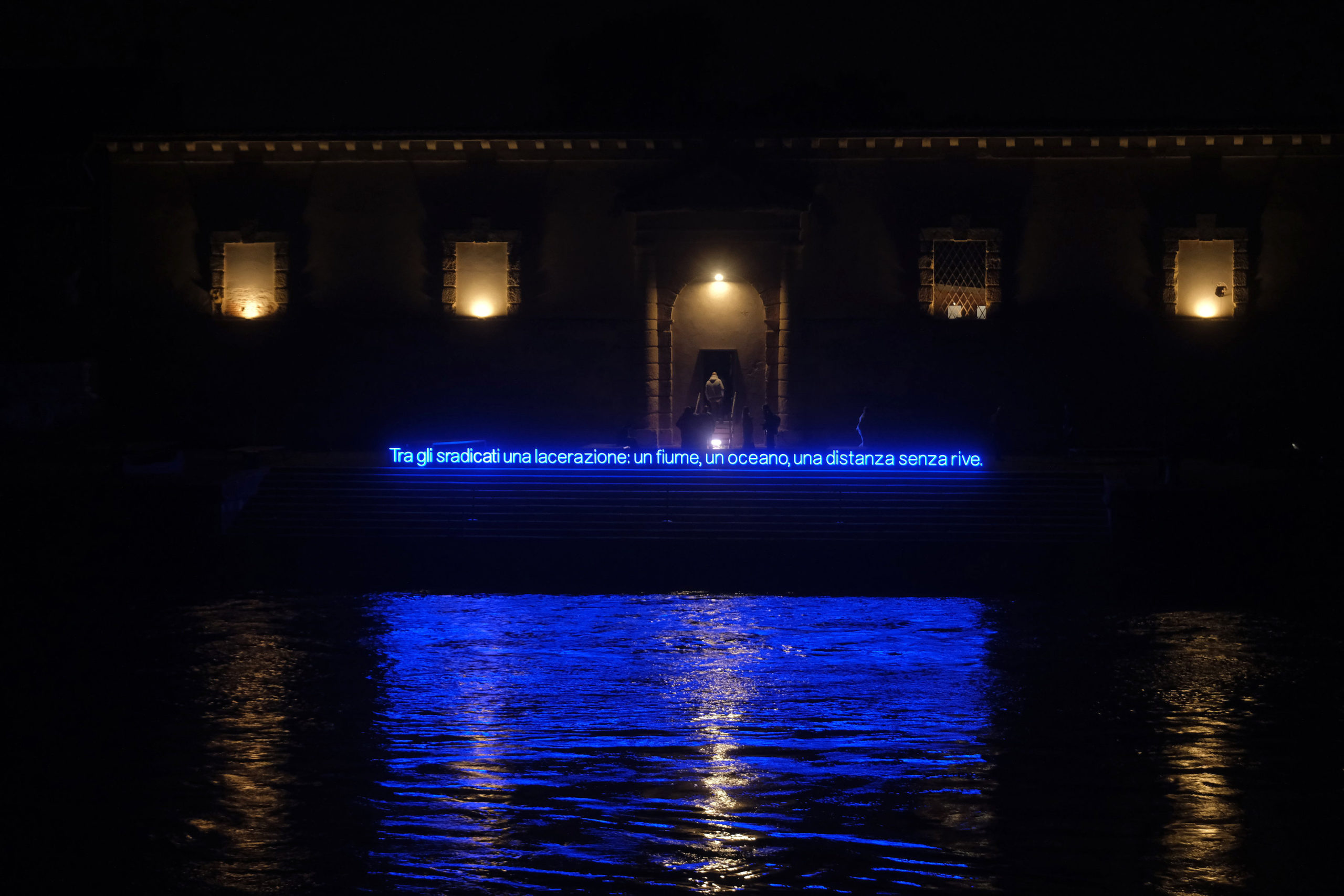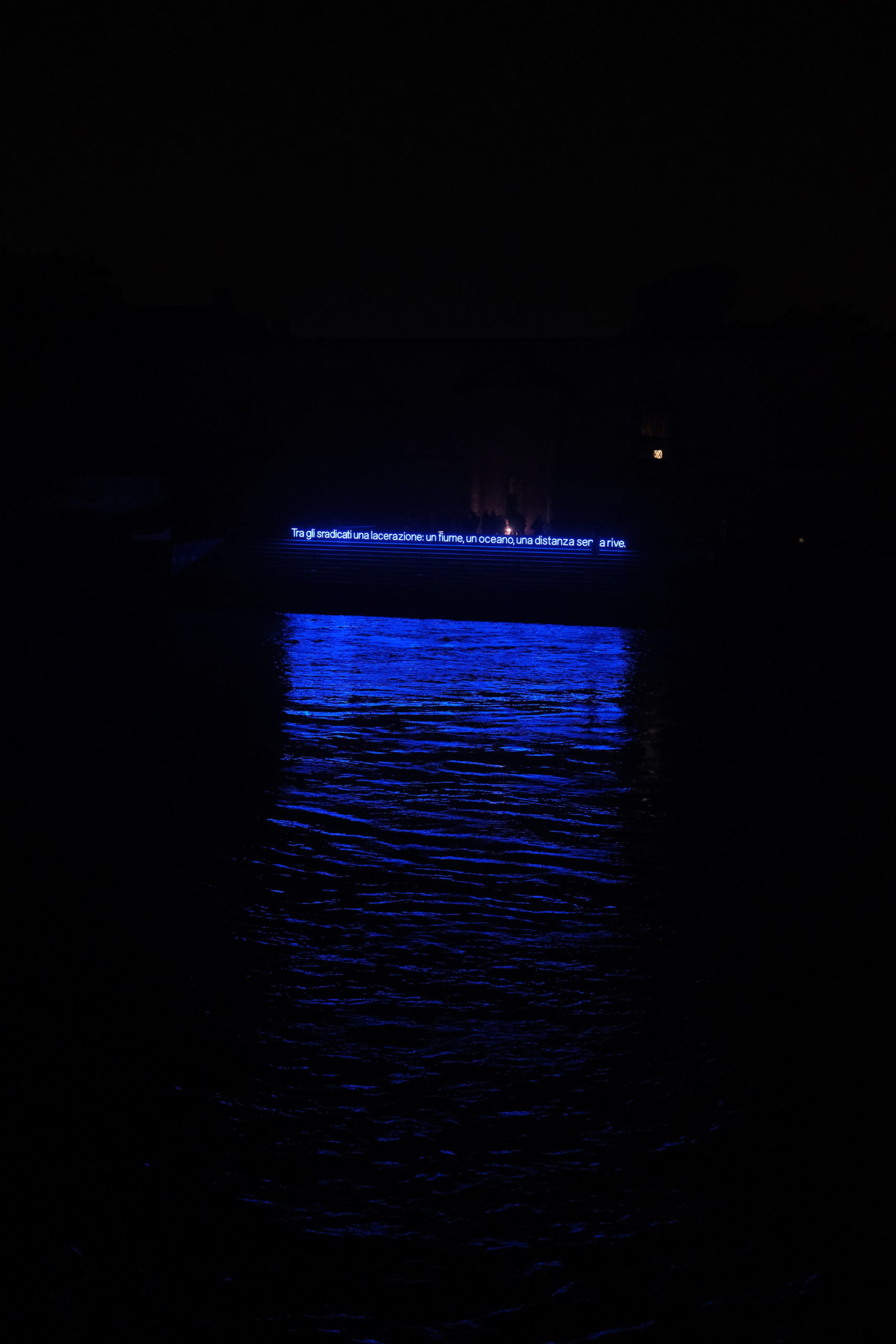The Dogana di fiume, a former custom house serving river trade in Verona, will host an installation and performance by Chilean artist Enrique Ramírez (b. 1979, Santiago; lives and works in Paris and Santiago). The project was conceived by Laura Lamonea and curated by Pascale Cassagnau, art critic and head of video and new media in the collection of CNAP_Centre national des art plastiques, Paris, an institution set up by the French Ministry of Culture and Communication.
In the artist’s vision, the site will become a space for reflection on migration, uprootedness and memory. On the entrance steps, between the Adige River and the building, a text will emerge as a symbolic threshold.
Simultaneously, a sound piece and a spatial performance titled A Shoreless Distance, created by the artist in collaboration with performer Camilla Monga, amplify the project’s poetic and political dimensions. The composition weaves together fragments of well-known quotes on exile, migration, and resistance, drawn from literature, political discourse, and poetry.
Ramírez’s project invites viewers to think of water as a border and memory, exploring uprootedness and distance through visual and auditory means. The Dogana di fiume, once a checkpoint for people and goods, will be given new life as a space for listening and reflection.
Exhibition opening hours:
Thurdsday 9 October from 9 p.m. to 10 p.m. (opening by invitation)
From Friday 10 to Sunday 12 October from 3 p.m. to 10 p.m.
From 13 to 26 October the exhibition will be visible from Lungadige Sammicheli
Curatorial text by Pascale Cassagnau
«To be haunted by a ghost means to have the memory of what one has never lived in the present.» Jacques Derrida, Ghost Dance
«I feel embarrassed when you ask me to tell you about my life. I have not had a life. I cannot remember. Emigrants are incapable of that. We, the persecuted of universal history, have been deprived of the possibility of a personal life.» Günther Anders, The Emigrant
«In French, there is only one term to designate the concept of «frontier». In English, there are several, and I have chosen two: border, the territorial and legal line that separates foreigners from nationals, or immigrants from natives; and boundary, which refers to the invisible and symbolic limits drawn between social categories and human groups.» Didier Fassin
For Enrique Ramírez, water is a critical zone without horizon, much like the sands of the Atacama Desert, both allegories of the fractures of time and History. Tra questi sradicati e la lacerazione, un fiume, un oceano, una distanza senza rive (Between these uprooted places and this tearing apart lies a river, an ocean, a shoreless distance): this is the title, written in neon, placed along the staircase of the Ex Dogana di Fiume, like a line of words that materializes a temporary boundary, a precarious horizon of perforated memories, memories celebrated by the poet Etel Adnan in her essay Van Gogh / Saint Augustine: A Literary Conversation, in which she reflects on Vincent van Gogh’s disorientation, torn apart from himself and from the society of the late nineteenth century, caught in what she calls « a theatre of inner struggle.» Etel Adnan makes memory the fundamental engine of thought in both of these creators.
In the performance A Shoreless Distance, conceived for ArtVerona 2025 with dancer Camilla Monga, the artist seeks to reconsider the horizon in its existential, imaginary, and material dimension, through an action that places the body in dialectical resonance with space, revealing all the tensions that arise from this confrontation.
The horizon line is, in fact, a central element of observation for travelers and navigators, an essential point of reference that manifests depth or its negation, the infinite or its opposite, the closure of space. The performance unfolds as an improvisation within a sound space traversed by bodies, where space and sound enter into dialogue, even with silence, thus generating tensions and ruptures.
The façade of the Ex Dogana di Fiume and the Adige River in Enrique Ramírez’s work materialize a fracture that evokes the migratory flows of time—passages, trade, and goods in transit. The live sound composition accompanying the line of words, visible and legible from the opposite riverbank, attests to the importance of sound in Enrique Ramírez’s practice. Militant voices, historical voices, submerged voices retrace the history of twentieth-century Italy, orchestrating the dialectic of conflicting memories—from Mussolini to Aldo Moro—sometimes even standing in opposition to History itself.
«Words float, but not all of them survive. Some sink, heavy with history; others resurface, like wrecks refusing to be forgotten. Rivers have heard the cries of war, the promises of empires that believed themselves eternal, the proclamations that set multitudes aflame » sings a voice-over. Here, the voices—with their diverse textures and distinctive timbres—outline a space that is both welcoming and contemplative: voices as the only and ultimate refuge of memory, as the expression of an art of the frontier and of the margins. In a play blending documentary and fiction, many contemporary works become a theatre staging the tragic awareness of time, while simultaneously holding it at a distance through the subtle alchemy of an emancipatory formal language.
Flight, pilgrimage, paths, exile, migration, immigration, crossings, abandonment, frontiers: many contemporary works express these conditions of exclusion and exile, which manifest not only as forced displacements but also as inner exile. This was already recognized long ago by the philosopher Julia Kristeva, who, speaking of her own exile, described the painful feeling of « being a stranger to oneself ».
Artists are sentinels in the clearing of time and History, witnesses of the present in a disoriented world with unstable boundaries. The works of Enrique Ramírez speak of turmoil and political contexts, of exodus and exile, as well as of the fatal discontinuity of memory, in a continuous search that leads him to rethink geographies, to observe exile from himself and from his community, despite the disorientation. In his manifesto text Ce que c’est que l’exil (What Exile Is), written in 1875, the writer Victor Hugo reminds us that the exile « dreams without rest. His steps along the seashore are not lost. He fraternizes with that power, the abyss. He looks at the infinite, he listens to the unknown».
Born in 1979 in Santiago de Chile, the photographer and filmmaker Enrique Ramírez studied music and cinema at the Arcos Institute in Santiago, and later at Le Fresnoy Studio National des Arts Contemporains in France. Matthias Puech, with whom Ramírez conceived the performance presented at the Ex Dogana di Fiume on October 9, 2025, is a musician, a specialist in digital sound environments, and a researcher whose work explores the ways nature, technology, and perception interact. Ramírez and Puech previously collaborated on a work for the Louvre-Lens, centered on the relationship between the language of the body and the language of music. From the perspective of a research-creation practice conceived as an open investigation into life stories, Enrique Ramírez has developed a working methodology based on the collection of visual and oral testimonies, which are then reworked and reintroduced into the settings of his films or into the texts accompanying his photographs. The fragmented narratives that emerge are not transcriptions but poetic and political translations of the gathered documentation.
The photographic series Calais, produced in 2009 in the Calais Jungle (officially known as Camp de la Lande), constitutes a living archive of survival habitats, which the artist systematically catalogs, like an anthropologist of precarious existences and of what the German philosopher Theodor W. Adorno called «mutilated lives».
Over the years, Enrique Ramírez has developed a body of work composed of films, installations, and photographs that revolve primarily around the themes of the sea, journeys, and exchanges between peoples. Works such as Horizon, Cruzar un muro, and Océan address questions of migration and the globalized economy of maritime trade, while Brises evokes the troubled history of Chile. The cinematic narratives that Ramírez explores in his works exist at the crossroads of documentary and fiction, taking a form akin to contemplative visual poetry. In a note written while composing the triptych Une Histoire sans destin (A Story Without Destiny), Ramírez states: «Our geography is both our political history and our way of forgetting. From this, our story is born. The film tells stories without apparent connection, as if it sought to reconstruct a new territory, a new geography, a new history».
The film Los Durmientes (2014) explores this political maritime history. First presented at the Palais de Tokyo in Paris, it evokes one of the atrocities of the Chilean dictatorship: victims—sometimes still alive, placed in sacks and tied to railway sleepers—were thrown into the sea from helicopters. The title Los Durmientes refers both to “the sleepers” and to the railroad ties themselves. The triptych presents three temporalities of this past, three acts evoked through long sequence shots. The landscape, breeze, water, and sand become allegories of these murders, offering a subjective interpretation and reappropriation of Chile’s history.
Similarly, Une histoire sans destin (2015) is a documentary-style triptych film, made on the 70th anniversary of the Normandy landings and filmed in both Normandy and Chilean Patagonia. The three stories in the work refer to different times and geographies, evoking complex maritime crossings and continental conquests, interwoven with the memory of the Chilean dictatorship, which remains deeply personal to the artist. With Une histoire sans destin, Ramírez reaffirms that sound in his work is as important as image sequencing and editing. He writes: «Histoire sans destin is a film that makes the off-screen space a fundamental element of its dramatic and narrative structure. The characters do not speak. The sound dimension compels the viewer to complete the image, to reconstruct what is not seen, starting from what is heard and imagined. How do we look at our cities? How do we forget our history, and how do we inhabit it under the weight of the past? What drives us to imagine? How can we give visible form to oblivion?».
In the exhibition Enrique Ramírez. Jardins Migratoires, organized as part of the Rencontres d’Arles at the École nationale supérieure de la photographie in 2021, the artist created a new work, Jardins migratoires, in collaboration with seven students from the school. The work took shape as a writing process developed from an epistolary exchange between the students and around one hundred residents of Arles, which took place in November 2020, during the second Covid lockdown.
The questions proposed by the artist were: What is your earliest memory? What would you ask of memory? What is the first place you see when you close your eyes? Which images would you like to bring into existence? Which image evokes a feeling of joy? Jardins Migratoires is a narrative, poetic, and political proposition, conceived in the very context of the pandemic, and developed from the imaginary fabric of memory, a memory deeply stimulated and unsettled in times of turmoil.
To bridge this profound disorientation, Enrique Ramírez’s films act as directional markers, guiding the viewer to confront both what reveals itself and what withdraws, inviting reflection on point of view, experience, and the position of subjects in space, whether physical or political.





